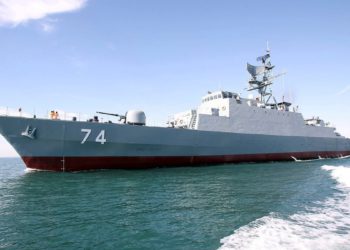
Many scenarios exist for conflict occurring between the United States and any number of nations and for any number of reasons. Regardless of the scenario, the United States has an impressive strike capability that could potentially cripple a sizable portion of an adversaries forces, whether it be land based targets or a their navy’s capital ships. In any case, the scope of limitations can be reduced to the following factors; the U.S inventory of on hand of munitions and the geographical location of any strike. Such strike capabilities, assumingly used as an initiation of hostilities will be further explored.
A phased approach by the United States consisting of 4 to 5 separate attacks, spaced apart by hours, all consisting of different strike platforms, would likely overwhelm and significantly damage any intended foe. Any large scale strike would require active ISR assets and mid-course guidance updates, both which the US has in abundance and has conducted numerous exercises employing. Despite recent reports of a low Operational Readiness rate, several platforms would likely receive additional funding and prioritization of support, days and weeks prior to the execution of any sizable operation commencing. Below, I will depict what one possible scenario could look like, based off of existing security challenges found today.
If the US found itself in a scenario in which the imminent threat of a conflict would likely occur, the US could in short order, ready several strike packages and execute pre planned, synchronized attacks, focusing on two primary objectives. The first would be the destruction of enemy High Payoff Targets (HPT) and then subsequently, the destruction of enemy High Value Targets (HVT). For the sake of argument, one such scenario exists and involves a nation found across the Pacific. Such a decision by the US would likely focus on reducing to the best extent possible, the most flexible option to be exercised by the threat in question, in the specific scenario, which in turn, would be likely predicated on that nation’s ability to execute their own strategies and more specifically, their power projection platforms.
In this scenario, likely strike packages could consist of several attacks by US forces at extended ranges and would employ strike missiles either in service or shortly coming into service, such as the Long Range Anti Shipping Missile and modernized Tomahawk cruise missiles. These strikes would be carried out by a wide array of platforms; air, surface and sub-surface platforms, also known as three dimensional threats. Further, they likely would be massed in well coordinated, separate strikes, initially aiming to degrade any defenses prior to the targeting of critical assets in order to facilitate further engagement options for day two and day three follow on operations.

In such a scenario, a logical question to as is what would such a series of strikes look like, what platforms would the US likely employ and particularly, what targets could be targeted? Currently, such an operation could be carried out by the following platforms, all armed with long range missiles, whether they be anti-shipping missiles or land attack missiles. Breaking down by degree of employment, the US could employ a small, dispersed surface strike force consisting of its two stealth destroyers, each armed with 80 Tomahawk missiles, for a total of 160 missiles, capable of flying nearly 900 nautical miles, with pinpoint accuracy. Additionally, a single formation of four Burke class destroyers or two separate formations, consisting of two each, would be capable of firing nearly 400 additional strike missiles. For a sub-surface strike package, the US could employ their converted Ohio class submarines, each carrying 150 long range missiles. Assuming that three of their boats were employed, that is an additional 450 missiles. Even further, the US could utilize either 4 of their Virginia class or older Los Angeles class submarines, for a total of 56 long range missiles. It is also likely that the US would also employ their Sea Wolf class submarines for operations, likely as a counter submarine force to ensure launch locations were sterile of any potential enemy surface and subsurface threats.

The newest capability the US has begun fielding is in the air. The US could employ 18 of their B-1B bombers, each armed with long range stealth missiles, capable of engaging targets over 300nm away, for a total of 432 missiles. The US would likely also employ 4 to 8 B-2 bombers for strategic targeting, and would likely carry somewhere between 64 and 128 missiles. Lastly, the US could employ 3 entire squadrons of the venerable B-52, each armed with 20 strike missiles, for another 1,080 missiles. Of critical importance here, the employment of the bombers would be in subsequent waves, targeting enemy assets that were within range, while being protected by flying in created corridors from previous initial strikes.
In totality, these strike formations consisting of 6 surface ships, 9 submarines, and half of its conventionally focused bomber formations could unleash a destructive barrage of nearly 2,400 Tomahawk (Land and Anti Shipping variants) and AGM-158 missiles, all aimed at an enemy’s HPT and HVT. Targeting could be augmented by supporting operations consisting of additional subsurface or surface actions, specifically targeting Early Warning radar sites, specifically selected airfields housing long range fighters, which would need to be denied taxing for the aerial strike packages to commence. Additionally, targets consisting of POL sites, constituting an enemy’s strategic oil reserves, could be attacked in follow on operations, as well as specific naval repair yards and ports, which would further complicate re consolidation of forces and recovery operations.
If the US wanted, a second strike package, consisting of a similar array of small, dispersed forces, could re attack any surviving targets within days or include a whole new array of targets, such as airfields, energy sector targets, or military command and control facilities. The only limiting factors here for US forces, is its inventory of long range weapons. No nation today possess such a first strike capability like the US does. If the US were to target a specific portion of a threat’s naval forces, no matter how many new ships they were intent on building, the surrounding waters would have an abundance of artificial coral reefs that would rival the Great Barrier Reef.










